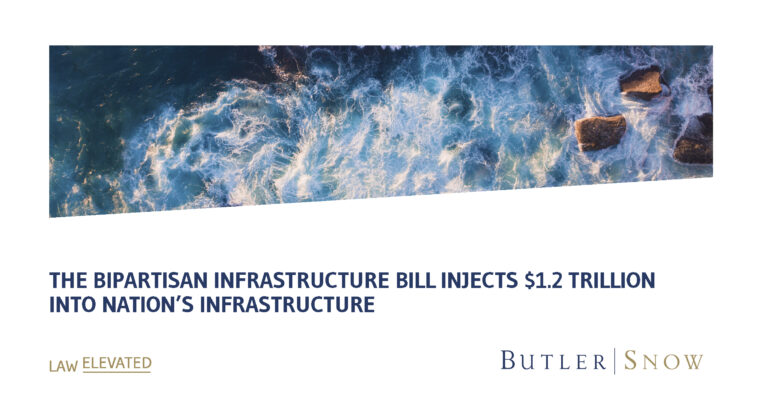November 10, 2021
The Infrastructure Investment and Jobs Act, otherwise known as the Bipartisan Infrastructure Bill, was passed by Congress and is set to inject $1.2 trillion into projects upgrading the nation’s roads, bridges, energy, water and broadband infrastructure. Some economists have predicted it will add millions of jobs over the coming decade.
On Friday, November 8, 2021, the House passed the infrastructure bill, sending the legislation to President Biden. President Biden has indicated that he plans to sign the infrastructure bill “soon” noting the bill is a “monumental step forward” towards addressing the climate crisis, creating jobs and easing “inflation pressures” for working families. The bipartisan bill seeks to increase government spending on roads, airports, bridges, public transit, water and broadband. The measure passed the House 228-206, while the Senate had already overwhelmingly passed the same legislation 69-30.
The business community strongly supported the infrastructure package, which directs $550 billion dollars in new spending. The five-year funding plan was paid for by a variety of funding sources, including dynamic scoring from economic gains due to the legislation, certain sales, and unspent Covid-19 relief funds.
The Infrastructure Investment and Jobs Act will impact states and municipalities of all sizes. The bulk of the funding is focused on improvements to traditional infrastructure projects including public transit, ports and roadways. The White House released a state-by-state breakdown of the impact of this legislation in August.
BIPARTISAN INFRASTRUCTURE DEAL
The Infrastructure Investment and Jobs Act details specific funding streams for the specific projects included in its provisions. Categories of projects included in the $550 billion in new spending are below. Full text of legislation.
**Listed below are highlights of many, but not all, of the provisions included in the Act**
- Roads, Bridges, & Major Projects: $110B — Funds new, dedicated grant program to replace and repair bridges and increases funding for the major project competitive grant programs. Preserves the 90/10 split of federal highway aid to states.
- Power and Grid: $65B — Funds grid reliability and resiliency projects and support for a Grid Development Authority; critical minerals and supply chains for clean energy technology; key technologies like carbon capture, hydrogen, direct air capture, and energy efficiency; and energy demonstration projects from the bipartisan Energy Act of 2020.
- Passenger and Freight Rail: $66B — Provides targeted funding for the Amtrak National Network for new service and dedicated funding to address repair backlogs. Increases funding for freight rail and safety with the largest federal investment passenger rail service since Amtrak was founded 50 years ago.
- Broadband: $65B — Funds grants to states for broadband deployment and other efforts to address access issues in rural areas and low-income communities. Expands eligible private activity bond projects to include broadband infrastructure.
- Resiliency: $47.2B — Funds cybersecurity projects to address critical infrastructure needs, flood mitigation, wildfire, drought, coastal resiliency, waste management, ecosystem restoration, and weatherization.
- Public Transit: $39.2B — Funds nation’s transit system repair backlog, which includes buses, rail cars, transit stations, track, signals, and power systems. This allocation also includes money to create new bus routes and increase accessibility to public transit for those with physical mobility challenges.
- Airports: $25B — Increases Airport Improvement grant amounts for runways, gates, & taxiways and authorizes a new Airport Terminal Improvement program.
- Addressing Legacy Pollution: $21B — Funds to clean up brownfield and superfund sites, reclaim abandoned mine lands, and plug orphan oil and gas wells, improving public health and creating good-paying jobs.
- Ports and Waterways: $16.6B — Provides funding for waterway and coastal infrastructure, inland waterway improvements, port infrastructure, and land ports of entry through the Army Corps, DOT, Coast Guard, the GSA, and DHS.
- Safety and Research: $11B — Addresses highway, pedestrian, pipeline, and other safety areas (highway safety accounts for the bulk of this funding). Includes a new Safe Streets and Roads for All grants program.
- Low-Carbon and Zero-Emission School Buses & Ferries: $7.5B — Funds and authorizes the adoption of low-carbon and zero-emission school buses, including through hydrogen, propane, LNG, compressed natural gas, biofuel, and electric technologies. Provides support for a pilot program for low emission ferries and rural ferry systems.
- Electric Vehicle Charging: $7.5B — Funds alternative fuel corridors and a national build out of electric vehicle charging infrastructure. The federal funding will have a focus on rural and/or disadvantaged communities.
- Reconnecting Communities: $1B — Provides dedicated funding for planning, design, demolition, and reconstruction of street grids, parks, or other infrastructure (funding is especially targeted at infrastructure which is deteriorating due to age).
